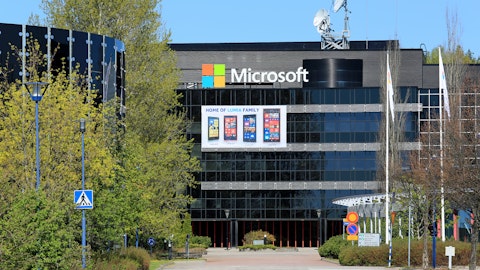James Fish: Hey guys. Most of mine have been asked. But I did want to ask, you guys raised prices about a year ago now versus kind of the backlog then. It would imply that we should be starting to get a benefit from that price increase on really gross margins now. So why shouldn’t, Ken, we get a bigger gross margin uplift in the back half of the year as a result of this kind of greater backlog flush freeing up that order that would have a higher price to it then? And what are you guys seeing with supply prices in terms of availability as well as the price itself versus the last year?
Ken Miller: Yes. So the pricing actions we took over the past couple of years are playing a benefit. If you were to look at our revenue growth this year that we just posted, 2% to 3% of that growth was likely you could attribute to pricing increases. And I think that’s going to roughly be the impact to revenue this full year, roughly 3%, give or take, of our growth of at least 9% would likely be tied to pricing. You’re also seeing that show up in the gross margin line. But just to remind you, our price increase wasn’t intended to recover gross margin. It was really about gross profit. So although gross margin is under pressure, we are offsetting the costs that we’re getting on a one-for-one basis. We’re just — we’re not creating 60% margin on the cost increases that we’re having to absorb, but we’re actually trying to offset those costs and make them one for one, which does result in margin, not necessarily bouncing back, but it does help the bottom line and obviously EPS.
So, as costs were to normalize and we could still hold price, that’s when you would start to see margin expansion because of the actions we took. So far, we’re not seeing supply costs come down materially at all. And maybe there might be a couple of components where you’re seeing some reductions, but for the most part, component pricing are staying fairly stable. We are seeing some good signs on the freight side. I will point out that we did see a reduction in freight costs on a per kilogram basis in Q1, and that was encouraging. So, some of those transitory costs on the freight side, we’re starting to see normalized, but on the other parts of the transitory costs, we have yet to see a meaningful reduction.
Operator: The next question is from Simon Leopold with Raymond James.
Unidentified Analyst: This is Victor in for Simon. Thanks for taking the question. In the past, you’ve discussed being intentional about taking share in metro edge routing. Can you tell us where you see your current share position and kind of what your targets are longer term? And maybe help us understand the key product differentiators in Juniper’s plan for displacing incumbents like Huawei?
Rami Rahim: Yes, certainly. So let me first talk a little bit about the market opportunity because if you look at the Service Provider vertical all up, there are different layers of that network, the layer of the network that, in fact, is growing the fastest from a total addressable market standpoint is the Metro, which is why we think it’s such an interesting area for us. Second, it’s relatively straightforward for Juniper to enter into this market segment because we have great customers that leverage our solutions in the core, in the edge, love our network operating system, Junos, and would love to see us extend that into the Metro layers of their network. In fact, we’ve already seen a number of wins with our ACX portfolio, which is the name of the product family that serves the Metro market as a result of customers just being familiar with and very much liking the operational aspects of our network operating system.
In terms of the opportunity, it’s still way more ahead of us than behind us because really the solution is just now coming together. The differentiation has to do with the fact that we’ve really built a sustainable portfolio that’s very power efficient, leverages the latest silicon technology, has certain embedded security capabilities. And very importantly, many of the lessons that we have learned in terms of the operations and automation of a network in our Enterprise segment with our Marvis AI ops engine, we are taking and applying to the Metro. And the customer feedback on that strategy has been phenomenal. So again, I feel really good about this part of the — this part of our strategy, and I think it can be very successful for us in the future.
And that weighs into why I’m somewhat bullish about SP for the year.
Unidentified Analyst: That’s helpful. And I think you touched on this a little bit earlier, but can you give us a little insight into the composition of the software? How much is hardware attached versus stand-alone, kind of what are the primary factors driving the demand for the software solutions?
Rami Rahim: Well, so software is pretty much an element of every strategic solution we’re selling across our three solution areas, right? In the enterprise, the Mist SaaS software is a necessary component of every solution that we sell across wireless, increasingly wired and WAN. In the data center space, the Apstra is an optional attach. However, it is the way in which we are competing and taking share most effectively in the data center segment today, and I’ve provided some color as to the growth that’s happening with Apstra-led data center wins. In the Service Provider space, this is a software solution we call Paragon that we’re really now sort of putting together, and we are seeing early sales in the Metro. But like I just mentioned, it’s still relatively early days right now in terms of the Metro opportunity. I’m not sure if I addressed your question, but I hope I did.
Unidentified Analyst: That’s good. That’s helpful. Thank you.
Rami Rahim: Thank you.
Operator: The next question comes from Tal Liani with Bank of America.
Unidentified Analyst: Hey. This is Tom Zilberman on for Tal. So going back to backlog, last quarter, your backlog declined between $250 million to $300 million sequentially, and you noted that you expected it to come down, but this quarter it accelerated to $350 million. So, any color on the acceleration of the drawdown versus your expectations 90 days ago? And does it — and do you think that we can reach that new or that normalized target by the end of this year? Thanks.





